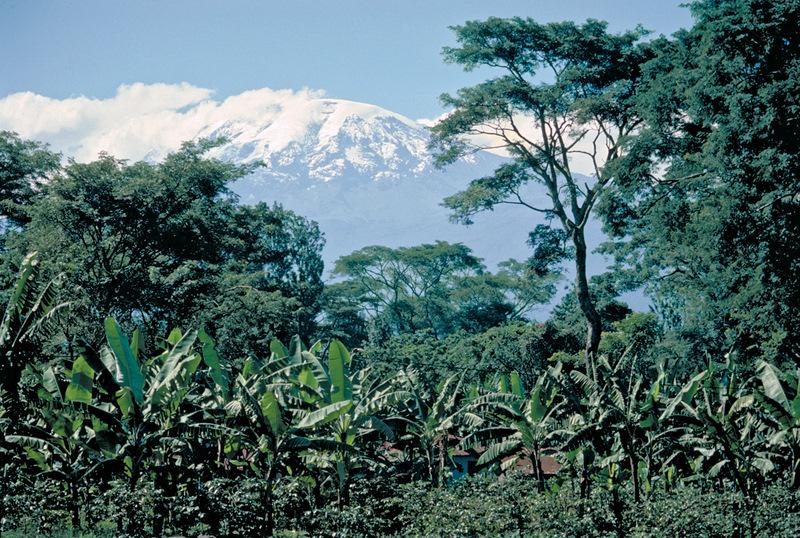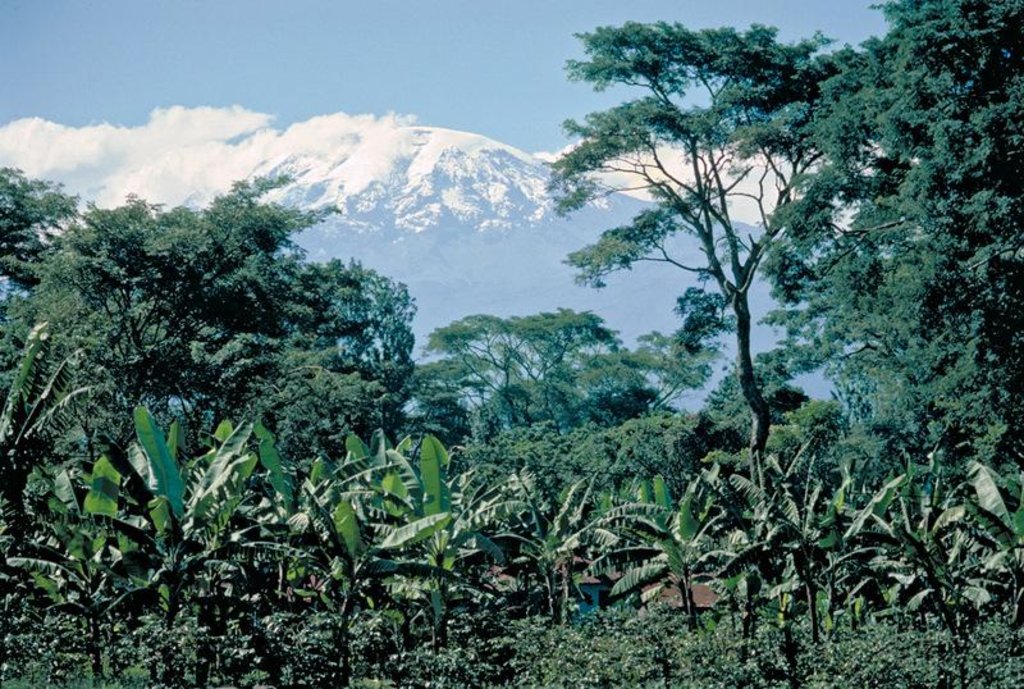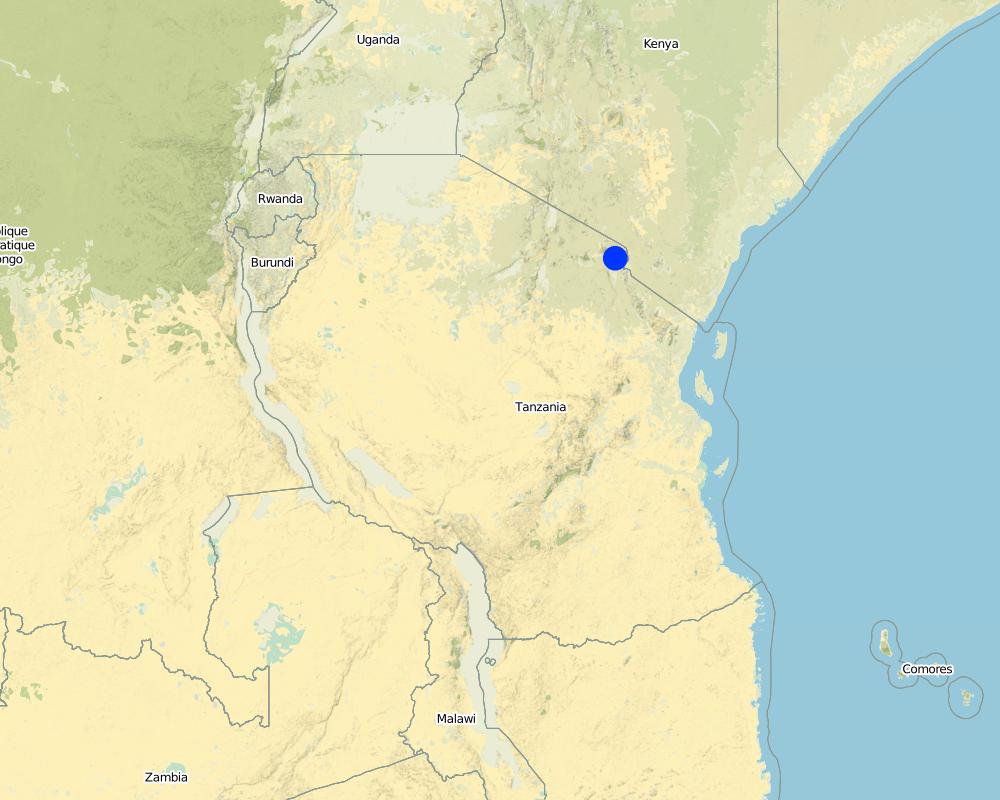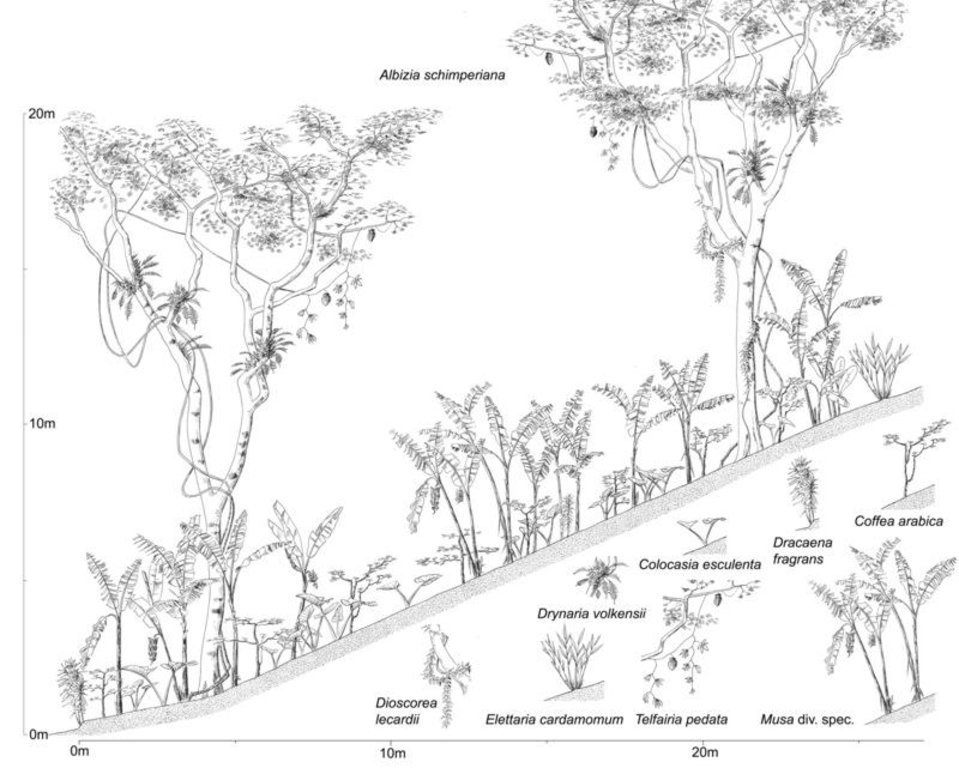Chagga Homegardens [坦桑尼亚联合共和国]
- 创建:
- 更新:
- 编制者: Unknown User
- 编辑者: –
- 审查者: Alexandra Gavilano, Deborah Niggli, David Streiff
technologies_1337 - 坦桑尼亚联合共和国
查看章节
全部展开 全部收起1. 一般信息
1.2 参与该技术评估和文件编制的资源人员和机构的联系方式
关键资源人
SLM专业人员:
Hemp Andreas
University of Bayreuth
德国
SLM专业人员:
Hemp Claudia
University of Würzburg
德国
有助于对技术进行记录/评估的项目名称(如相关)
Book project: SLM in Practice - Guidelines and Best Practices for Sub-Saharan Africa (SLM in Practice)有助于对技术进行记录/评估的机构名称(如相关)
Universität Bayreuth (UBT) - 德国有助于对技术进行记录/评估的机构名称(如相关)
Julius-Maximilians-Universität Würzburg (JMU) - 德国1.3 关于使用通过WOCAT记录的数据的条件
编制者和关键资源人员接受有关使用通过WOCAT记录数据的条件。:
是
2. SLM技术的说明
2.1 技术简介
技术定义:
The Chagga homegardens are traditional, densely planted ‘banana forests’ with a scattered upper tree layer.
2.2 技术的详细说明
说明:
The complex multicropping system evolved over several centuries through a gradual transformation of the natural forest on the footslopes of Kilimanjaro. A Chagga homegarden has an average size of 0.68 ha and integrates numerous multipurpose trees and shrubs with food crops, and stall-fed animals, without a specific spatial arrangement. However, vertically, the following 4 stories/canopies can be distinguished: (1) food crops: taro, beans, vegetables and fodder herbs / grasses; (2) coffee: 500-1,400 plants/ha; (3) banana: primary crop; 50% cover; 330-1,200 clumps/ha; and (4) Trees, such as Cordia abyssinica, Albizia schimperiana and Grevillea robusta. The trees provide shade for coffee, act as live fences, provide medicines, firewood, fodder, mulching material, bee forage; and some have pesticidal properties (e.g. Rauwolfia caffra). This multilayer system maximizes the use of limited land in a highly populated area, making sustained production possible with a minimum of external inputs, minimizes risk (less production failure, increased resistance against droughts and pests) and ensures at the same time environmental protection. The large species diversity provides both subsistence and cash crops. Parts of the homegarden area are irrigated and drained by a network of over 1000 canals and furrows tapping runoff from the montane forest. However, many systems are now in disrepair.
Natural / human environment: Starting in the 1930s when coffee took more space from the food production, it became necessary to expand food production to the lowlands. Today, the Chagga highland homegarden works only in combination with a lowland field where maize, millet, beans, sunflower and groundnuts are grown to ensure food security.
2.3 技术照片
2.5 已应用该技术的、本评估所涵盖的国家/地区/地点
国家:
坦桑尼亚联合共和国
有关地点的进一步说明:
Mt. Kilimanjaro Region
注释:
Total area covered by the SLM Technology is 1200 km2.
individual homegardens are 0.68 ha on average
Map
×2.6 实施日期
如果不知道确切的年份,请说明大概的日期:
- 50多年前(传统)
2.7 技术介绍
详细说明该技术是如何引入的:
- 作为传统系统的一部分(> 50 年)
3. SLM技术的分类
3.1 该技术的主要目的
- 改良生产
3.2 应用该技术的当前土地利用类型
同一土地单元内混合使用的土地::
是
具体说明混合土地使用(作物/放牧/树木):
- 农林业

农田
- 一年一作
- 多年一作(非木材)
- 乔木与灌木的种植
年作 - 具体指明作物:
- 饲料作物 - 草
- 饲料作物 - 其他
- 蔬菜 - 其他
- Taro
多年生(非木质)作物 - 指定作物:
- 香蕉/芭蕉/蕉麻
乔木和灌木种植 - 指定作物:
- 鳄梨
- 咖啡,露天种植
每年的生长季节数:
- 2

森林/林地
- Cordia abyssinica, Albizia schimperiana and Grevillea robusta
产品和服务:
- 薪材
- 其它森林产品
- 放牧/啃牧
注释:
Type of cropping system and major crops comments: Chagga homegardens are traditional, densely planted ‘banana forests’ with a scattered upper tree layer
3.3 由于技术的实施,土地使用是否发生了变化?
由于技术的实施,土地使用是否发生了变化?:
- 是(请在技术实施前填写以下有关土地利用的问题)
同一土地单元内混合使用的土地::
是
具体说明混合土地使用(作物/放牧/树木):
- 农林业

森林/林地
3.4 供水
该技术所应用土地的供水:
- 混合雨水灌溉
3.5 该技术所属的SLM组
- 农业林学
- 家庭花园
3.6 包含该技术的可持续土地管理措施

植物措施
- V1:乔木和灌木覆盖层

管理措施
- M5:物种组成的控制/变化
注释:
Type of vegetative measures: scattered / dispersed
3.7 该技术强调的主要土地退化类型

土壤水蚀
- Wt:表土流失/地表侵蚀

化学性土壤退化
- Cn:肥力下降和有机质含量下降(非侵蚀所致)
注释:
Main type of degradation addressed: Wt: loss of topsoil / surface erosion, Cn: fertility decline and reduced organic matter content
3.8 防止、减少或恢复土地退化
具体数量名该技术与土地退化有关的目标:
- 防止土地退化
4. 技术规范、实施活动、投入和成本
4.1 该技术的技术图纸
技术规范(与技术图纸相关):
Typical chagga homegarden on a 45% slope at 1400 m a.s.l. with 4 vegetation layers: open light upper canopy with Albizia schimperiana (up to 20 m high); upper shrub layer with banana (4-6 m); a lower shrub layer with coffee (1.5-2 m) and food crops such as taro (< 1.5 m) -2.5 m; 3-6 m; 5-30 m
Mt. Kilimanjaro Region
Date: 2009
Technical knowledge required for field staff / advisors: moderate
Technical knowledge required for land users: moderate
Main technical functions: control of raindrop splash, stabilisation of soil (eg by tree roots against land slides), increase in organic matter, increase in nutrient availability (supply, recycling,…), increase of infiltration, increase of biomass (quantity), promotion of vegetation species and varieties (quality, eg palatable fodder)
Scattered / dispersed
Vegetative material: T : trees / shrubs
Trees/ shrubs species: Cordia abyssinica, Albizia schimperiana, Grevillea robusta, Rauwolfia caffra, Persea americana
Fruit trees / shrubs species: banana, avocado, mango
Perennial crops species: taro, coffee
Grass species: fodder herbs / grasses
Change of land use type: from natural forests to agroforest
作者:
Hemp, A. / Hemp, C.
4.2 有关投入和成本计算的一般信息
具体说明成本和投入是如何计算的:
- 每个技术单元
指定单位:
homegarden
具体说明成本计算所用货币:
- 美元
4.3 技术建立活动
| 活动 | 时间(季度) | |
|---|---|---|
| 1. | Transforming the native forest: trees that provided fodder, fuel, fruits, medicines, shade, timber, bee forage, anti-pest properties are retained while the less useful species are eliminated | |
| 2. | Introduction of new fruit and timber tree species, such as avocado, mango, Grevillea robusta, Persea americana | |
| 3. | Planting crops species (banana, coffee, taro, beans, vegetables) | |
| 4. | Establishment of irrigation/drainage channels | |
| 5. | Terracing or building of bunds in steep places |
4.5 维护/经常性活动
| 活动 | 时间/频率 | |
|---|---|---|
| 1. | Planting, tending and harvesting of bananas, taro, yams / Opening up the canopy to ensure better fruiting of the coffee | all year round |
| 2. | Spacing out the banana stools; Manuring crops (using dung from the stall-fed livestock and compost) | |
| 3. | Lopping fodder trees/shrubs; Pruning and spraying against coffee berry disease and leaf rust | |
| 4. | Maintaining irrigation furrows; Coffee harvest | August to January |
| 5. | Tending and milking the stall-fed cows (typically only one cow) / Mulching, terrace maintenance (soil erosion prevention in general) |
4.6 维护/经常性活动所需要的费用和投入(每年)
| 对投入进行具体说明 | 单位 | 数量 | 单位成本 | 每项投入的总成本 | 土地使用者承担的成本% | |
|---|---|---|---|---|---|---|
| 劳动力 | Planting, tending and harvesting | unit | 1.0 | 300.0 | 300.0 | 100.0 |
| 设备 | Tools | unit | 1.0 | 45.0 | 45.0 | 100.0 |
| 肥料和杀菌剂 | Compost / manure | unit | 1.0 | 100.0 | 100.0 | 100.0 |
| 技术维护所需总成本 | 445.0 | |||||
| 技术维护总成本,美元 | 445.0 | |||||
注释:
Machinery/ tools: axes, hoes, pangas (machetes)
5. 自然和人文环境
5.1 气候
年降雨量
- < 250毫米
- 251-500毫米
- 501-750毫米
- 751-1,000毫米
- 1,001-1,500毫米
- 1,501-2,000毫米
- 2,001-3,000毫米
- 3,001-4,000毫米
- > 4,000毫米
有关降雨的规范/注释:
depending on slope orientation and altitude
农业气候带
- 半湿润
Thermal climate class: tropics
Tropical montane; bimodal: long rains in March-May, short rains in Nov-Dec
5.2 地形
平均坡度:
- 水平(0-2%)
- 缓降(3-5%)
- 平缓(6-10%)
- 滚坡(11-15%)
- 崎岖(16-30%)
- 陡峭(31-60%)
- 非常陡峭(>60%)
地形:
- 高原/平原
- 山脊
- 山坡
- 山地斜坡
- 麓坡
- 谷底
垂直分布带:
- 0-100 m a.s.l.
- 101-500 m a.s.l.
- 501-1,000 m a.s.l.
- 1,001-1,500 m a.s.l.
- 1,501-2,000 m a.s.l.
- 2,001-2,500 m a.s.l.
- 2,501-3,000 m a.s.l.
- 3,001-4,000 m a.s.l.
- > 4,000 m a.s.l.
关于地形的注释和进一步规范:
Slopes on average: Also steep (31-60%)
Altitudinal zone: 1000-1800 m.a.s.l.
Landforms: Orientation south / south-east
5.3 土壤
平均土层深度:
- 非常浅(0-20厘米)
- 浅(21-50厘米)
- 中等深度(51-80厘米)
- 深(81-120厘米)
- 非常深(> 120厘米)
表土有机质:
- 高(>3%)
如有可能,附上完整的土壤描述或具体说明可用的信息,例如土壤类型、土壤酸碱度、阳离子交换能力、氮、盐度等。:
Soil fertility is high
5.5 生物多样性
物种多样性:
- 高
5.6 应用该技术的土地使用者的特征
生产系统的市场定位:
- 混合(生计/商业)
相对财富水平:
- 贫瘠
个人或集体:
- 个人/家庭
机械化水平:
- 手工作业
说明土地使用者的其他有关特征:
Land users applying the Technology are mainly disadvantaged land users
Population density: > 500 persons/km2
5.7 应用该技术的土地使用者使用的平均土地面积
- < 0.5 公顷
- 0.5-1 公顷
- 1-2 公顷
- 2-5公顷
- 5-15公顷
- 15-50公顷
- 50-100公顷
- 100-500公顷
- 500-1,000公顷
- 1,000-10,000公顷
- > 10,000公顷
这被认为是小规模、中规模还是大规模的(参照当地实际情况)?:
- 小规模的
5.8 土地所有权、土地使用权和水使用权
土地所有权:
- 个人,未命名
- 个人,有命名
土地使用权:
- 个人
注释:
traditional clan regulations (land cannot be sold to outsiders)
6. 影响和结论性说明
6.1 该技术的现场影响
社会经济效应
生产
木材生产
注释/具体说明:
Fuelwood production 1.5-3 m3/ha/year
生产故障风险
产品多样性
注释/具体说明:
185 kg beans/ha; 410 kg coffee/ha; 400 bunches of banana /ha; ca. 30 kg honey/ha
收入和成本
工作量
注释/具体说明:
increased labour efficiency
其它社会经济效应
value of gene pool
注释/具体说明:
for breeding programmes to improve crop varieties for multistorey cropping systems
社会文化影响
食品安全/自给自足
健康状况
preservation of traditional knowledge
生态影响
土壤
土壤覆盖层
土壤流失
生物多样性:植被、动物
植物多样性
注释/具体说明:
over 500 plant species including 400 non-cultivated plants
动物多样性
害虫/疾病控制
其它生态影响
micro-climate
biodiversity / crop diversity
注释/具体说明:
? land use change from natural forest to agroforest
6.3 技术对渐变气候以及与气候相关的极端情况/灾害的暴露和敏感性(土地使用者认为的极端情况/灾害)
渐变气候
渐变气候
| 季节 | 增加或减少 | 该技术是如何应对的? | |
|---|---|---|---|
| 年温度 | 增加 | 好 |
气候有关的极端情况(灾害)
气象灾害
| 该技术是如何应对的? | |
|---|---|
| 局地暴雨 | 好 |
| 局地风暴 | 好 |
气候灾害
| 该技术是如何应对的? | |
|---|---|
| 干旱 | 好 |
水文灾害
| 该技术是如何应对的? | |
|---|---|
| 比较和缓的(河道)洪水 | 好 |
其他气候相关的后果
其他气候相关的后果
| 该技术是如何应对的? | |
|---|---|
| 缩短生长期 | 好 |
注释:
the system has a high buffer capacity (micro-climate, biodiversity, irrigation)
6.4 成本效益分析
技术收益与技术维护成本/经常性成本相比如何(从土地使用者的角度看)?
短期回报:
积极
长期回报:
非常积极
6.5 技术采用
- > 50%
在所有采用这项技术的人当中,有多少人是自发的,即未获得任何物质奖励/付款?:
- 91-100%
注释:
100% of land user families have adopted the Technology without any external material support
Comments on adoption trend: Locally well adopted traditional land use system, covering an area of approximately 1200 km2; further spread at local level is not possible due to land shortage.
6.7 该技术的优点/长处/机会
| 编制者或其他关键资源人员认为的长处/优势/机会 |
|---|
| this system allows for maintaining high biodiversity at the same time with diversified production of fruits, vegetables, timber, medicinal products etc. |
6.8 技术的弱点/缺点/风险及其克服方法
| 土地使用者认为的弱点/缺点/风险 | 如何克服它们? |
|---|---|
| High demand of wood, low coffee prices and the introduction of sun-tolerant coffee varieties endanger the homegardens | incentive-based tree planting in the gardens to reduce the pressure on the forest |
| 编制者或其他关键资源人员认为的弱点/缺点/风险 | 如何克服它们? |
|---|---|
| Productivity of Chagga homegardens is not optimal | (1) Replace the less productive trees / shrubs with fast growing nitrogen fixing species; (2) improve animal husbandry (e.g. to increase lactation period), (3) improve apiculture, |
| Productivity of Chagga homegardens is not optimal | (4) introduce new crop varieties using the gene pool developed by natural and farmer selection, (5) use fertilizers, |
| Productivity of Chagga homegardens is not optimal | (6) improve coffee production: certified production (organic, fair trade) to fetch higher prices, (7) replace old coffee plants with new ones, (8) integrated pest management, (9) facilitate access to capital for farm investments |
| Productivity of Chagga homegardens is not optimal | (10) improve erosion control (terraces and bunds), (11) include productive fruit trees, (12) improve advisory services |
| Water management causes nutrient loss in the gardens and water shortages on the lower slopes | improve efficiency of furrows: Install pipes and surfacing by cement, protect river banks from cultivation |
7. 参考和链接
7.2 参考可用出版物
标题、作者、年份、ISBN:
Hemp, A. (1999): An ethnobotanical study on Mt. Kilimanjaro. Ecotropica 5: 147-165
标题、作者、年份、ISBN:
Hemp, A. (2006): The banana forests of Kilimanjaro. Biodiversity and conservation of the agroforestry system of the Chagga Homegardens. Biodiversity and Conservation 15(4): 1193-1217.
标题、作者、年份、ISBN:
Hemp, C. (2005): The Chagga Home Gardens – relict areas for endemic Saltatoria Species (Insecta: Orthoptera) on Mt. Kilimanjaro. Biological Conservatrion 125: 203-210.
标题、作者、年份、ISBN:
Hemp, A., C. Lambrechts, and C. Hemp. (in press). Global trends and Africa. The case of Mt. Kilimanjaro. (UNEP, Nairobi)
标题、作者、年份、ISBN:
Hemp, A., Hemp, C., Winter, C. (2009) Environment and worldview: The Chagga homegardens. In: Clack, T.A.R. (ed.) Culture, history and identity: Landscapes of inhabitation in the Mount Kilimanjar area, Tanzania. BAR International Series 1966, Archaeopress Oxford, pp. 235-303
标题、作者、年份、ISBN:
Fernandes E.C.M., Oktingati A., Maghembe J. 1985. The Chagga homegardens: a multistoried agroforestry cropping system on Mt. Kilimanjaro (Northern Tanzania) in Agroforestry Systems 2: 73-86
链接和模块
全部展开 全部收起链接
无链接
模块
无模块





